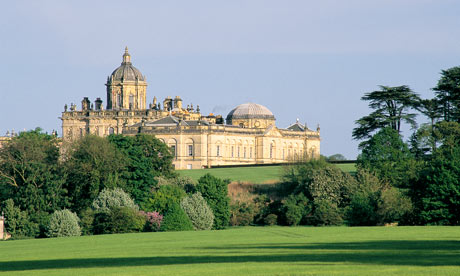
On a wintery Monday in February, as dusk gathers, I find myself on a muddy footpath in deep woodland with a fell terrier called Wilf. We are having a frank discussion on the legal rights of pheasants, something Wilf seems unable to grasp. This stretch of countryside, I try to convey, is not a wilderness playground, but a human invention governed by property rights. The pheasants, in other words, belong.
We are in the Howardian Hills, a stretch of low ridges and mounds to the north-east of York that conceal some delightful valleys and villages. Few tourists come here, but the map reveals a clutch of lost parklands, some interesting ruins, and some long-distance footpaths I've never heard of.
Centenary Way, anyone? Built to commemorate 100 years of the North Yorkshire County Council. But the route looks good. Britain is full of these well-intentioned paths that rarely get a mention, and Wilf and I are on a two-day mission to do them justice.
Suddenly a roe deer bounds out in front of us. Deer and Wilf exchange a look, then the deer bolts into the woods in a fury of snapping twigs, followed by a furry red cannonball. I sit on a log and wait. Our legal debate, I deduce, is over.
We had started at Kirkham Priory, a ruined 12th-century Augustinian monastery in a lovely curl of wooded valley on the banks of the Derwent. There was a fence, an English Heritage ticket office and a padlocked gate, which Wilf nonchalantly leapt over. I went after him, discovering the ruins are definitely worth a stroll, should you find a ticket person.
Hound recaptured, I proceeded upriver through thick woods to cross the A64 and enter the Castle Howard estate. We found our first folly, a four-faced stone on top of a stepped plinth. According to the map there was a second folly nearby, a pyramid, but a PRIVATE sign firmly denoted the limits of public access. Wilf, against legal advice, went and checked it out.
Further on, the landscape was dotted with the extravagances of the third Earl of Carlisle: a second pyramid, the Howard family mausoleum, the Temple of the Four Winds, and the house itself.
Somewhere in these grounds had once been the village of Henderskelfe, a centuries-old settlement caught trespassing on His Lordship's land in 1699 and summarily demolished. Gentleman playwright and ex-con John Vanbrugh designed a Baroque mansion masterpiece and his assistant, Nicholas Hawksmoor, dotted the parkland with symbols, follies and statuary. The result is easily the most fascinating slice of parkland in Britain. Wilf, overcome with excitement, left a small mark of canine admiration on a stone plinth.
Back on the Centenary Way we headed north to Slingsby Bank, an east-west ridge that gave us fine views of the North York Moors. This was my favourite part of the walk. The ridge is gnarled with ancient earthworks, some perhaps thrown up by the Celtic Parisi tribe, who moved here from Gaul in pre-Roman times (Paris was named after them). Now it is a wonderful natural hideaway for wildlife. This was where the deer popped out on us and Wilf set off to fully exercise his native freedoms.
"In the name of Henderskelfe," I thought I could hear him barking as he charged back and forth. "No man can own mountains!"
In the end I put him on the lead. It was getting dark and we still had a couple of miles to our destination, leaving the Centenary Way on another long-distance path, the Ebor Way.
The lights were all on in the village of Hovingham when we arrived. I washed Wilf and my boots in the stream then walked up to the Worsley Arms Hotel. Hovingham is a delightful spot, much of which is part of another large estate, belonging to the Worsley family.
Leaving my best friend in the room, with firm injunctions to stay off the bed, I went out to eat at The Star, an award-winning pub in the neighbouring village of Harome that was really worth the detour. The bed, of course, was warm when I got back.
Next morning we walked with Paul Jackson of the Howardian Hills Area of Outstanding Natural Beauty. Much of the area, he said, had once been large estates and parks: "The Industrial Revolution passed the whole area by."
In the 1930s the mass trespass movement was pressing for public access to walking country. After the second world war, Britain was surveyed for areas with natural beauty and leisure potential. The big beasts – Dartmoor, the Peak District, the North York Moors – became national parks, but lesser areas became Areas of Outstanding Natural Beauty, of which there are now 48. They don't have the budgets or legal powers of their larger cousins, but the AONBs nevertheless contain some of Britain's best countryside.
Leaving Paul at Cawton, I walked past drifts of snowdrops to Yearsley Woods, dotted with old fish ponds built by the monks of Ampleforth Abbey. At Yearsley we summited: 174m above sea level and a great panorama west towards the Dales. We pressed on through glorious countryside and thick mud down another long-distance path, the Foss Walk, to yet another pretty village, Crayke, our final destination. In the Durham Ox pub I sank a well-earned pint of Black Sheep.
Wilf threw himself down in front of the fire, just as if he owned it.
• Kevin's accommodation and dinner were arranged by Welcome to Yorkshire (yorkshire.com). For day walks in the Howardian Hills see howardianhills.org.uk. Details of long-distance footpaths all over the UK from ldwa.org.uk. The Worsley Arms in Hovingham (01653 628234, worsleyarms.co.uk) has doubles from £130 B&B. A two-night break, including breakfast and tickets to Castle Howard, costs £175 for two. The Star Inn at Harome (01439 770397, thestaratharome.co.uk), from £20 for two courses

